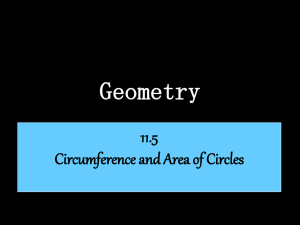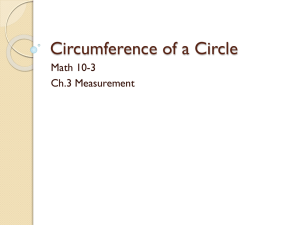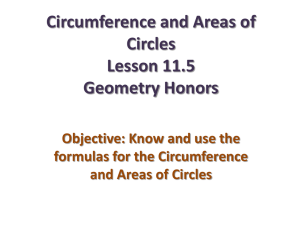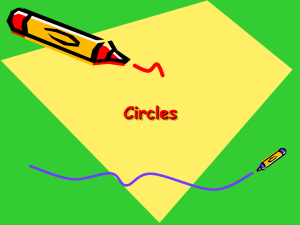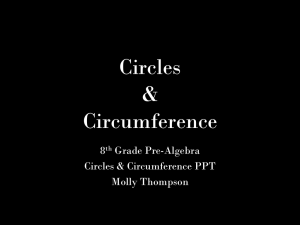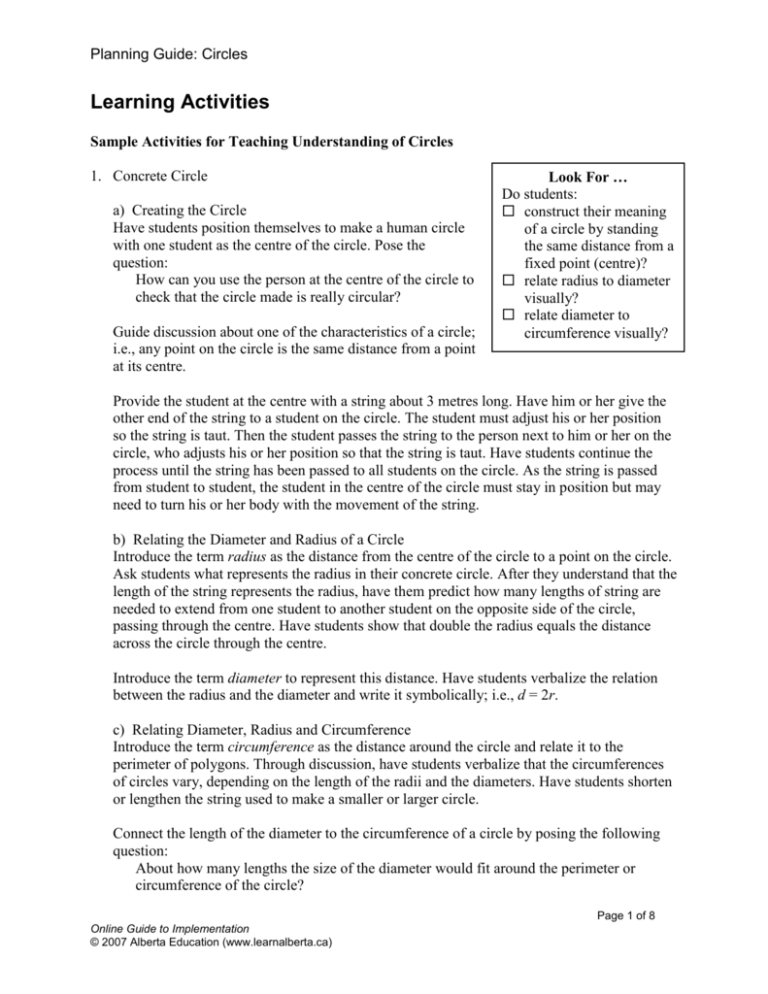
Planning Guide: Circles
Learning Activities
Sample Activities for Teaching Understanding of Circles
1. Concrete Circle
a) Creating the Circle
Have students position themselves to make a human circle
with one student as the centre of the circle. Pose the
question:
How can you use the person at the centre of the circle to
check that the circle made is really circular?
Guide discussion about one of the characteristics of a circle;
i.e., any point on the circle is the same distance from a point
at its centre.
Look For …
Do students:
construct their meaning
of a circle by standing
the same distance from a
fixed point (centre)?
relate radius to diameter
visually?
relate diameter to
circumference visually?
Provide the student at the centre with a string about 3 metres long. Have him or her give the
other end of the string to a student on the circle. The student must adjust his or her position
so the string is taut. Then the student passes the string to the person next to him or her on the
circle, who adjusts his or her position so that the string is taut. Have students continue the
process until the string has been passed to all students on the circle. As the string is passed
from student to student, the student in the centre of the circle must stay in position but may
need to turn his or her body with the movement of the string.
b) Relating the Diameter and Radius of a Circle
Introduce the term radius as the distance from the centre of the circle to a point on the circle.
Ask students what represents the radius in their concrete circle. After they understand that the
length of the string represents the radius, have them predict how many lengths of string are
needed to extend from one student to another student on the opposite side of the circle,
passing through the centre. Have students show that double the radius equals the distance
across the circle through the centre.
Introduce the term diameter to represent this distance. Have students verbalize the relation
between the radius and the diameter and write it symbolically; i.e., d = 2r.
c) Relating Diameter, Radius and Circumference
Introduce the term circumference as the distance around the circle and relate it to the
perimeter of polygons. Through discussion, have students verbalize that the circumferences
of circles vary, depending on the length of the radii and the diameters. Have students shorten
or lengthen the string used to make a smaller or larger circle.
Connect the length of the diameter to the circumference of a circle by posing the following
question:
About how many lengths the size of the diameter would fit around the perimeter or
circumference of the circle?
Page 1 of 8
Online Guide to Implementation
© 2007 Alberta Education (www.learnalberta.ca)
Planning Guide: Circles
After students make their predictions, have the student in the centre take the string and
repeatedly use it as a measure of the circumference. (Note: if done accurately, a little more
than 6 radii are needed to measure the circumference of the circle.) Pose the following
question:
If about 6 lengths of string, each representing the radius of the circle, are needed to
measure the circumference of the circle, how many lengths of string the size of the
diameter of the circle would be needed ? Explain your thinking.
2. Drawing Circles with and without a Compass
Provide students with 30-cm rulers, paper clips, string and
pencils. Have them work in groups to devise a way to
construct a circle. One student might hold the pencil in a
paper clip for the centre of the circle while another student
holds the other pencil that traces the pathway of the circle.
Have them label the radius, diameter and circumference.
circle pathway
pencil
pencil
(centre of circle)
paper clip
string
Look For …
Do students:
transfer their
understanding of a
concrete circle using a
string to a pictorial
circle?
measure the length of
string accurately for the
given radius?
relate diameter to radius
when given the diameter
of a circle that they are
to construct?
Then have students construct circles of various sizes with
given radii and diameters; e.g., radius is 5 cm, diameter is
12 cm. Instruct them to label the lengths of the radius and diameter for each circle.
Encourage them to predict the circumference of each circle and then use string to measure it
and verify the prediction.
Provide students with compasses. Have them explore constructing circles, using a compass
and ruler. Remind them to label the length of the radius and the diameter of each circle. If
necessary, model the construction of a circle with a compass by using an overhead projector
or a compass on the board.
Page 2 of 8
Online Guide to Implementation
© 2007 Alberta Education (www.learnalberta.ca)
Planning Guide: Circles
3. Exploring Pi
Introduce this activity by reading part of the book Sir
Cumference and the Dragon of Pi: A Math Adventure
(1999) by Cindy Neuschwander. Provide students with
labelled lids of various sizes and string to use as they are
actively involved in simulating the story.
The main character in the book is Radius, son of Sir
Cumference. During the story, Radius is watching his sister
bake pies. She uses pie dough to make lattice strips as the
top crust. Each strip fits all the way across the pie through
the centre. Have students cut string to simulate a strip that
is the diameter of the lid. Explain that Radius is laying the
strips around the edge of the pie. Have students predict how
many strips Radius will need to go around the edge of the
pie (or to complete the circumference of the pie).
After students make their predictions, have them verify
their predictions by cutting a piece of string the length of
the diameter of their lid and repeatedly using it to measure
the circumference of that lid. Have students share their
results. They should conclude that it takes a little more than
3 lengths of string the size of the diameter of a given circle
to complete the circumference of that circle.
Look For …
Do students:
translate the action in
the story to the action of
measuring various
circular lids?
predict the relation
between the diameter
and the circumference
by using their
background knowledge
from previous activities?
accurately record their
measures for the
diameter and
circumference of each
circle?
discover the constant—
the relationship between
the circumference and
the diameter of any
circle?
Have students measure the length of the diameter and the circumference of each lid and
record the results in a class chart posted on the overhead or the board. To measure the
circumference, have students place a string around the circumference of the lid and then
measure the length of string. Ask students to predict the entries for the circumference
diameter in the chart.
Circle or Lid
Diameter in cm
Circumference in
cm
Circumference
Diameter
(to 2 decimal places)
A
B
C
Encourage students to use calculators to complete the last column of the chart. Then continue
on with the story to determine if Radius' explorations lead to the same conclusions. If
necessary, have students record more data, using different lids to verify that the quotient of
the circumference divided by the diameter is always a little more than 3.
Introduce the term pi and the Greek symbol for it— . Explain that an approximate value for
pi is 3.14. You may wish to introduce irrational numbers at this point, explaining that the
Page 3 of 8
Online Guide to Implementation
© 2007 Alberta Education (www.learnalberta.ca)
Planning Guide: Circles
value for pi is nonrepeating and nonterminating and therefore not rational (of the form a/b,
where a and b are integers and b is not equal to zero).
Encourage students to use the button on the calculator to explore the decimal notation for
.
4. Research Activity
Continue the discussion of by reviewing that is the ratio of
the circumference of a circle to the diameter of that circle and
C
can be written symbolically as = . Review that cannot
d
be written as a repeating or terminating decimal because it is
an irrational number.
Pose the following question:
C
C
Since = , a fraction, then can be represented by a
d
d
repeating or terminating decimal. Why is not equal to a
repeating or terminating decimal and yet it is equal to a
fraction?
Look For …
Do students:
actively research pi and
explain how pi can be a
nonrepeating,
nonterminating decimal
and also be a ratio or a
fraction (C/d)?
communicate clearly the
results of the research
related to the question
posed about pi?
Have students do some research on this question by interviewing staff members, their family
or community members. They may also use the Internet to research this question; e.g., The
Math Forum Web site.
Through discussion, have students verbalize that for to be equal to a nonrepeating,
nonterminating decimal, then either the diameter or the circumference or both must be a
measure that is a nonrepeating, nonterminating decimal. Remind students that all measures
are approximate so they are not aware when a certain measure may be a nonrepeating,
nonterminating decimal.
5. Graphing the Circumference and the Diameter
Have students construct a scatter plot or a line graph, labelling the horizontal axis "diameter,"
and the vertical axis "circumference."
Page 4 of 8
Online Guide to Implementation
© 2007 Alberta Education (www.learnalberta.ca)
Planning Guide: Circles
Students may use their lids from Activity 3 to graph the
diameter and the circumference of each lid. They can place
the lid along the horizontal axis and mark the diameter,
then roll the lid along the vertical axis and mark the
circumference.
circumference
(cm)
diameter (cm)
lid
Alternately, students can use the data collected in their
charts in Activity 3 to plot the points (diameter,
circumference) on the graph.
Have students write an equation for the line graph that
relates the circumference of a circle to its diameter; i.e., C
C
= d or = .
d
Look For …
Do students:
graph the points
representing the
diameter and
circumference for
circles so that a linear
relation is shown
visually?
use the formula for the
circumference of a circle
to add more points to the
graph?
interpret the graph by
finding the diameter or
circumference, given
one of these measures?
Explore various problems in which the circumference, diameter or radius is provided and the
other two measures must be calculated.
6. Sum of the Central Angles
Provide students with scrap paper, compasses or traceable lids,
pencils and paper. Have them construct circles by tracing lids
or using a compass. Pose the following problem:
Explain how you would find the sum of the central angles
of any circle without using a protractor. A central angle is
an angle with its vertex at the centre of the circle and its
arms intersecting the circle.
central angle
Look For …
Do students:
apply their knowledge
of angles and degrees in
finding the sum of the
central angles of a
circle?
explain, using a variety
of strategies, why the
sum of the central
angles is always equal to
360o?
Encourage students to share their strategies. Students should build on their understanding of
180o being a semi-circle; therefore, the complete circle will be 360o. Other students may
build on their understanding that a right angle is 90o and there are four 90o central angles in a
circle; therefore, 4 x 90o = 360o.
Page 5 of 8
Online Guide to Implementation
© 2007 Alberta Education (www.learnalberta.ca)
Planning Guide: Circles
Still other students may apply their knowledge that the sum of the angles of any quadrilateral
is 360o by tearing off the vertices of any quadrilateral and arranging them so the vertices all
meet in the centre of a circle.
Quadrilateral
Rearrange vertices
Vertices as central angles in a circle
7. Concept Definition Map
Provide students with a template of a concept definition map to
complete for circles. The map can be done together as a class,
a small group or individually, depending on the needs of
students. As students complete the map, they consolidate their
understanding of circles and review some of the big ideas. A
sample concept definition map for circles is provided below.
Look For …
Do students:
write a definition for a
circle in their own
words?
explain the essential
characteristics of circles,
based on explorations of
a circle?
provide examples and
nonexamples to clarify
the characteristics of
circles?
Page 6 of 8
Online Guide to Implementation
© 2007 Alberta Education (www.learnalberta.ca)
Planning Guide: Circles
Concept Definition Map
Category
What is it?
2-dimensional
Figure
Properties
What are its characteristics?
The circumference is the distance
around a circle.
The diameter of a circle is always
twice the radius of that circle.
Word
Circle
The ratio of the circumference to the
diameter of any circle is constant
and is named pi ( ).
Multiplying the diameter of a circle
by pi ( ) results in obtaining the
circumference of that circle.
The sum of the central angles of any
circle is 360o.
Circumference
Find the length of
fencing needed to
enclose a circular
lot with a radius
of 10 m.
Find the length of
fencing needed to
enclose a rectangular
lot with an area of 12
m2 .
Radius Diameter
Examples
Nonexamples
Format adapted from Robert M. Schwartz, "Learning to Learn Vocabulary in Content Area Textbooks," Journal of Reading 32, 2
(1988), p. 110, Example 1. Adapted with permission from International Reading Association.
Page 7 of 8
Online Guide to Implementation
© 2007 Alberta Education (www.learnalberta.ca)
Planning Guide: Circles
8. Pop Cans and Tennis Balls
Provide a pop can for each group of students. Present
students with the following problem:
Predict whether the distance around a pop can is more
than, less than or the same as the height of the pop can.
Explain your thinking.
Have students share their predictions and explanations.
Guide the discussion to use the length of one finger as the
distance across the pop can (the diameter). Since the
circumference of the pop can is about three times the
diameter, it is necessary to decide if the height of the pop
can is more than, less than or equal to three finger lengths
with each finger length equivalent to the diameter. Of
course, the pop can is less than three finger lengths with
each finger length equivalent to the diameter of the can.
Look For …
Do students:
apply their
understanding of the
relation between the
diameter and the
circumference of a circle
to make accurate
predictions?
justify their predictions?
use previous predictions
and verifications to
refine their predictions
and justify them?
Provide students with string to measure the circumference of the pop can and verify their
predictions.
Provide students with other cylindrical containers to predict and then determine if the
circumference of the container is more than, less than or equal to the height of the container.
Adapted from Marilyn Burns, "A Can of Coke Leads to a Piece of Pi," Journal of Staff Development 25, 4 (Fall 2004), pp.
16, 18. Used with permission of the National Staff Development Council, www.nsdc.org, 2007. All rights reserved.
Include the cylindrical container for three tennis balls as one example. Through discussion,
students should explain that the tennis ball container would be about as tall as the distance
around the container. The three balls (representing the height of the container) are three times
the diameter of the container (Alberta Education 2005, p. 53).
Page 8 of 8
Online Guide to Implementation
© 2007 Alberta Education (www.learnalberta.ca)



